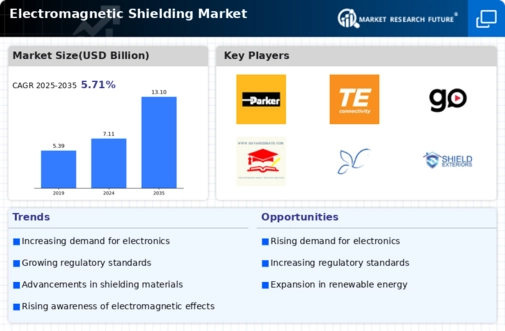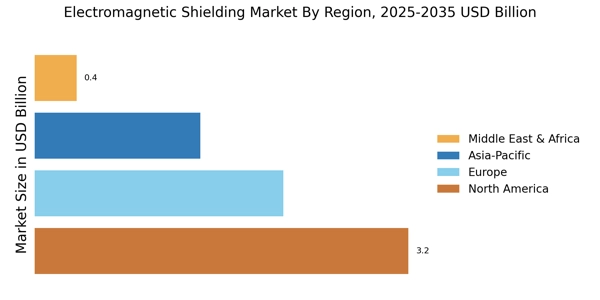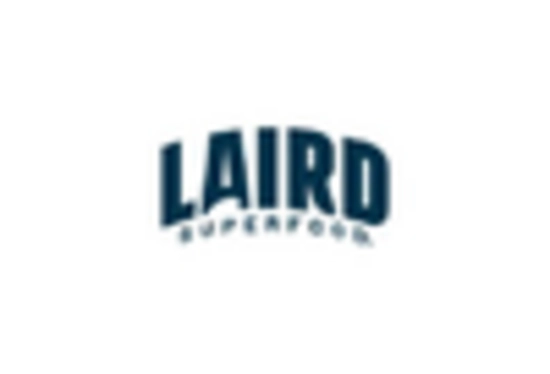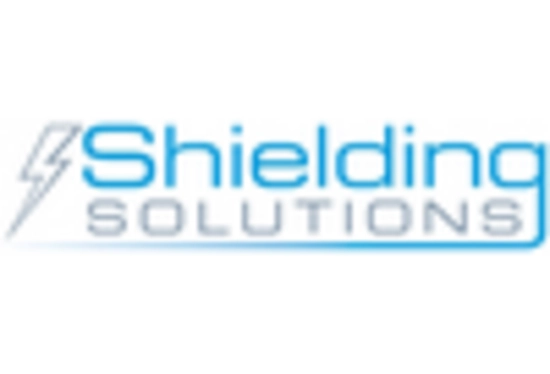Regulatory Standards and Compliance
The imposition of stringent regulatory standards regarding electromagnetic emissions is a significant driver for the Electromagnetic Shielding Market. Governments and regulatory bodies are increasingly mandating compliance with EMI regulations to protect both consumers and the environment. This regulatory landscape compels manufacturers to adopt effective shielding solutions to meet compliance requirements. Industries such as telecommunications, healthcare, and aerospace are particularly affected, as they must adhere to rigorous standards to ensure product safety and reliability. The market is likely to see a surge in demand for shielding materials that not only comply with these regulations but also enhance product performance, thereby fostering innovation in shielding technologies.
Growing Demand in the Automotive Sector
The automotive sector is experiencing a transformative shift towards electric and autonomous vehicles, which significantly influences the Electromagnetic Shielding Market. As vehicles become increasingly reliant on electronic systems for navigation, safety, and entertainment, the need for effective electromagnetic shielding becomes critical. The integration of advanced shielding solutions is essential to protect sensitive electronic components from EMI, ensuring optimal performance and safety. Market analyses suggest that the automotive segment could account for a considerable share of the overall shielding market, with expectations of a CAGR exceeding 7% in the next few years. This trend underscores the importance of shielding technologies in supporting the evolution of modern vehicles.
Advancements in Technology and Materials
Technological advancements in materials science are propelling the Electromagnetic Shielding Market forward. Innovations in conductive polymers, metal composites, and nanomaterials are enabling the development of more efficient and lightweight shielding solutions. These advancements not only improve the effectiveness of shielding but also reduce the overall weight and cost of electronic devices. For instance, the introduction of flexible shielding materials has opened new avenues in consumer electronics, where space and weight are critical factors. The market is witnessing a shift towards these advanced materials, with projections indicating a substantial increase in their adoption across various sectors, including aerospace and defense, where stringent performance standards are paramount.
Increasing Electromagnetic Interference (EMI) Concerns
The rising prevalence of electronic devices has led to heightened concerns regarding electromagnetic interference (EMI). As more devices operate simultaneously, the potential for EMI increases, which can disrupt performance and lead to malfunctions. This situation drives the demand for effective shielding solutions within the Electromagnetic Shielding Market. Industries such as telecommunications and automotive are particularly affected, as they rely on the seamless operation of electronic components. The market for EMI shielding materials is projected to grow significantly, with estimates suggesting a compound annual growth rate (CAGR) of over 6% in the coming years. This growth indicates a robust need for innovative shielding solutions to mitigate EMI risks, thereby enhancing device reliability and performance.
Rising Awareness of Health Risks Associated with EMF Exposure
There is a growing awareness regarding the potential health risks associated with electromagnetic field (EMF) exposure, which is influencing the Electromagnetic Shielding Market. As consumers become more informed about the implications of prolonged exposure to EMF, there is an increasing demand for shielding solutions that can mitigate these risks. This trend is particularly evident in residential and commercial sectors, where individuals seek to protect themselves from EMF emissions generated by electronic devices. Market Research Future indicates that the demand for residential shielding solutions is on the rise, with expectations of a notable increase in product offerings aimed at reducing EMF exposure. This heightened awareness is likely to drive innovation and expansion within the shielding market.


















Leave a Comment